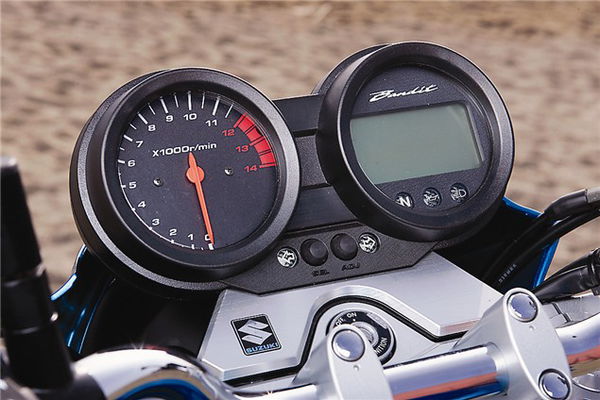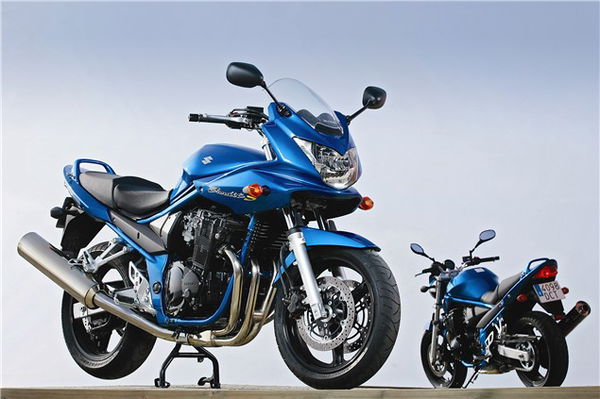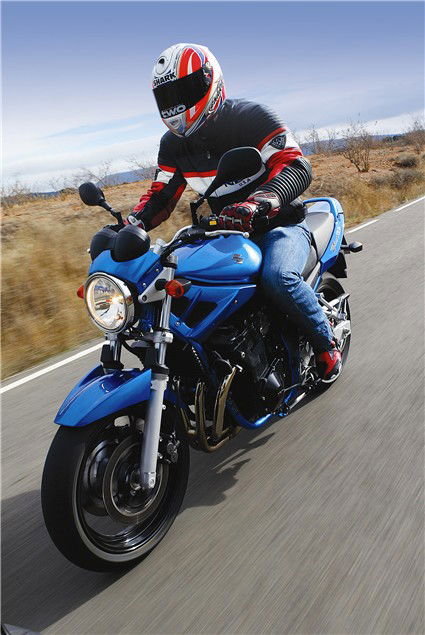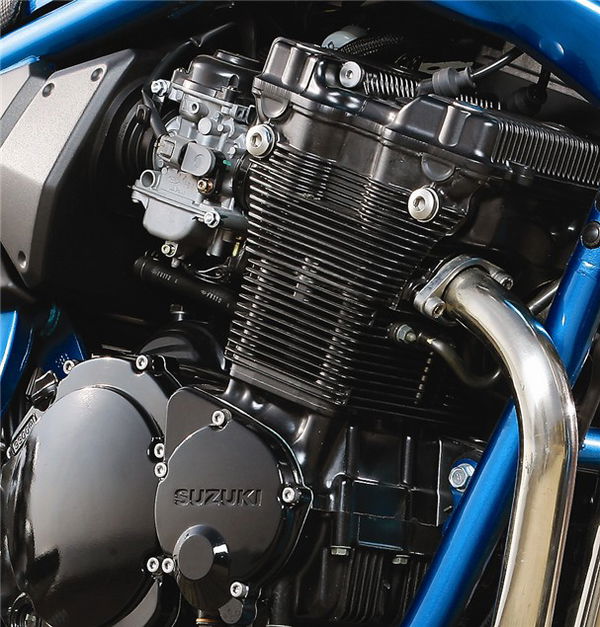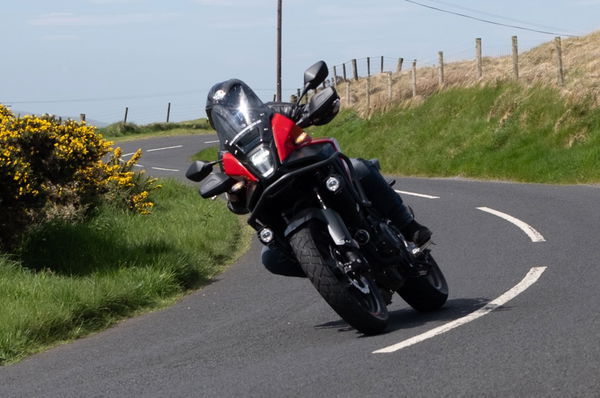First Ride: 2005 Suzuki Bandit 650-650S
Suzuki's trusty Bandit has swollen in capacity for 2005, but is this enough to put the planet's longest-serving middleweight back in the frame?

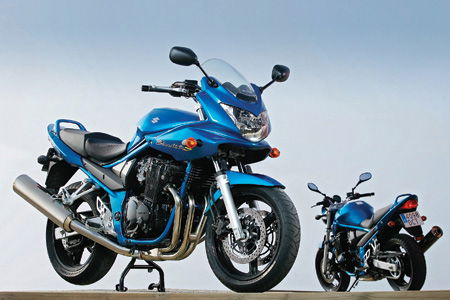 |
Sitting in the press briefing room at the launch of the Bandit 650 I got the feeling the Suzuki bods were struggling through the technical description of their new bike.
There was nothing wrong with their grasp of the English language, it's just that the new Bandit isn't a hell of a lot different from the old model, and they had to draw this out over an hour-long presentation.
For the sake of keeping this launch report short I'll cut to the chase. First up the engine. Well, it's now black rather than silver, so 650 owners can now pretend their bike is a 1200 Bandit as this previously was the main visual difference. The 600 has also grown to 656cc with a bigger bore, has a new cylinder design with a low friction coating, some new pistons and a new cam shaft. Even peak power is the same as before at a claimed 76.9bhp, although torque is up to 43.3lb.ft from 39.8lb.ft.
That's the engine, now the chassis.The frame is stiffer with an extra brace and, while the wheelbase is unaltered, the rake is one degree more and trail increased by 9mm. The suspension components are basically the same, although the forks now have adjustable spring pre-load.
To make the bike more appealing to a wide range of riders the Bandit's seat can be raised by 20mm from 770mm to 790mm and the bars can go up 10mm. The tank is slightly narrower too, making it even easier for short-arses to reach the ground, and for the more cautious rider the Bandit now also comes with ABS as an optional extra.
Which leaves the styling. Despite the new Bandit looking virtually identical to the old one it has new clocks, a pointy mudguard and new-style seat. The faired one gets a new fairing and I think there was also something about new indicators and tail light, but by this point my attention was dwindling.
As you can tell this isn't exactly a radical new bike. It's not even much of a change from the old one, and that hasn't really changed for 10 years. So what's going on? Suzuki admit the Bandit is out of its league against the new breed of sporty, liquid-cooled, aluminium-framed middleweights. Instead, it's now targeted against bikes such as Honda's CBF600. The Bandit is now a budget bike aimed mainly at new riders.
And it has to be ridden with this in mind because, quite frankly, a Z750, 600 Hornet or FZ6 could run rings around it. So the question should be, 'Is it much better than the old model and will it be any good as a cheap, reliable day-to-day bike?'
To be fair the Bandit isn't a bad bike at all, it's just not that inspiring if you are used to slightly sportier machinery, which most riders this bike is aimed at won't be.
To sit on the bike feels exactly the same as the old machine, with the new clocks and fork tops the only real clues that it's the new model. The seat is decently padded, bars at a comfortable distance and pegs positioned for comfort rather than ground clearance (something Suzuki had clocked as none of the bikes we rode had hero blobs fitted).
To go with the refined image the clocks have lost their tacky plasti-chrome look, and the speedo is now a digital display with sensible things like fuel gauge, clock and speed all there for your visual pleasure.
Get it going and the first surprise is how good the fuel-injection is with none of the usual jerkiness or snatch that usually accompanies injectors. Hang on a second, there's a reason for this. The Bandit has carbs. I tell you, these carb things could really catch on because they are brilliant. It's a refreshing change to ride a bike once again with them fitted as they are so much better than injectors, even the current ones.
There's no snatch going from a closed to open throttle or vice versa, no jerkiness and all-in-all the fuelling is perfect. Damn those EU idiots and their emissions laws for killing carbs off! Although the smooth delivery could be down to the engine as well.
While the 656cc motor is definitely stronger than the old model it's still not very powerful, and that makes for a smooth ride. The main benefits of the extra bore are below 7000rpm where it feels much improved - nothing like as strong as the Z750 but close to the Fazer 600 and Hornet, and I reckon it's stronger than Honda's CBF600. Accelerate on the CBF600 and it feels like the engine is restricted as it strains to build speed, but there is nothing of this about the Bandit. You just get silky acceleration with a light clutch action and smooth, if noisy, gearbox.
As improvements go the engine is a step ahead of the old model, although experienced riders will find they start using the throttle like an on/off switch on fast stretches of road. By 9500rpm the power is all but gone though, and you get the 'flogging a dead horse' feeling.
Come the corners the familiar Bandit bounce is kept in the new model. While the spring preload can be adjusted in the forks it isn't really going to make much of a difference as the whole bike is softly sprung. Tip it into a bend and it rocks gently on its suspension from front to back. Even for less experienced riders it lacks a certain amount of confidence, especially if there is a bump or any unevenness on the road. Chuck in a few extra worries mid-corner and it's not too hard to tie it up in knots. But once again, is the targeted Bandit rider really going to ride at this pace? At gentle cornering speeds it isn't that bad, and the benefit of soft suspension is a smooth ride over bumps.
Like the other models of Bandit, the 650 comes in a faired or naked version. Although Suzuki claims the new-style fairing is more efficient than the all-encompassing old model's, I'm not 100% sure if this is true. And I certainly got wet when it rained!
So why would you buy a new Bandit? Is it the price? At around £4200 for a naked or £4600 for faired it's well priced. But then again, with a bit of effort a Hornet, Triumph Speed Four, Z750 and Fazer 600 can all be found within a few hundred pounds, and an SV650 for under £4000 isn't hard to locate. And they are all better machines. Honda's CBF600 has a much more quality feel but for my money the Bandit's look and engine is better. Price wise there isn't much splitting them, but I'd probably chose the Honda over the Bandit, especially the naked version.
But there's a catch. Although the Bandit's RRP is £4200 the chances are it will actually cost much nearer £3700, which is close to a grand saving over the others and makes it more of a contender. Add in the look, which is classic, and the Bandit is more appealing.
The Bandit has a cult following, unlike most other middleweights, which will be a selling point. If it's cheap enough the new Bandit is a good, comfortable city bike with a smooth engine and light clutch, just not so much fun when the pace ups.
Think of it as a middle-aged office worker who has been to the gym in an effort to get rid of some of the wobbly bits and appear a bit more macho to the secretary. At the end of the day he is reliable, settled and built for comfort. A workout can only shed a few pounds, although he may last a bit longer. A safe bet, but if she wants something racier and more likely to keep the fires of passion burning then she'll go for a younger buck.
VERDICT
A solid, comfortable basic commuter aimed at newer riders. The motor is stronger but the chassis isn't very sporty
SPECS
TYPE - STREETBIKE
PRODUCTION DATE - 2005
PRICE NEW - £4200 / £4600 FAIRED
ENGINE CAPACITY - 656cc
POWER - 73.6bhp@9850rpm
TORQUE - 41.9lb.ft@7500rpm
WEIGHT - 201kg
SEAT HEIGHT - 770mm
FUEL CAPACITY - 20L
TOP SPEED - 129.5mph
0-60 - n/a
TANK RANGE - 156MILES
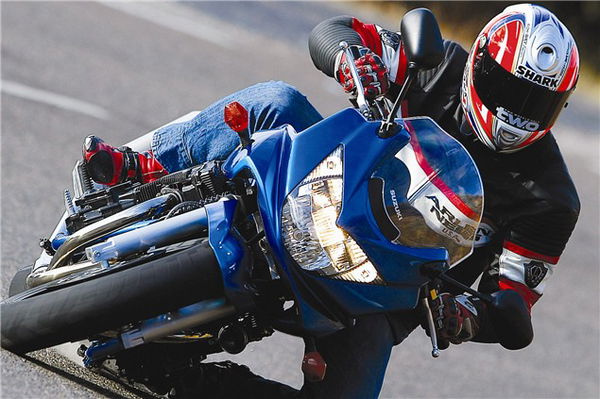
Sitting in the press briefing room at the launch of the Bandit 650 I got the feeling the Suzuki bods were struggling through the technical description of their new bike.
There was nothing wrong with their grasp of the English language, it's just that the new Bandit isn't a hell of a lot different from the old model, and they had to draw this out over an hour-long presentation.
For the sake of keeping this launch report short I'll cut to the chase. First up the engine. Well, it's now black rather than silver, so 650 owners can now pretend their bike is a 1200 Bandit as this previously was the main visual difference. The 600 has also grown to 656cc with a bigger bore, has a new cylinder design with a low friction coating, some new pistons and a new cam shaft. Even peak power is the same as before at a claimed 76.9bhp, although torque is up to 43.3lb.ft from 39.8lb.ft.
That's the engine, now the chassis.The frame is stiffer with an extra brace and, while the wheelbase is unaltered, the rake is one degree more and trail increased by 9mm. The suspension components are basically the same, although the forks now have adjustable spring pre-load.
To make the bike more appealing to a wide range of riders the Bandit's seat can be raised by 20mm from 770mm to 790mm and the bars can go up 10mm. The tank is slightly narrower too, making it even easier for short-arses to reach the ground, and for the more cautious rider the Bandit now also comes with ABS as an optional extra.
Which leaves the styling. Despite the new Bandit looking virtually identical to the old one it has new clocks, a pointy mudguard and new-style seat. The faired one gets a new fairing and I think there was also something about new indicators and tail light, but by this point my attention was dwindling.
As you can tell this isn't exactly a radical new bike. It's not even much of a change from the old one, and that hasn't really changed for 10 years. So what's going on? Suzuki admit the Bandit is out of its league against the new breed of sporty, liquid-cooled, aluminium-framed middleweights. Instead, it's now targeted against bikes such as Honda's CBF600. The Bandit is now a budget bike aimed mainly at new riders. And it has to be ridden with this in mind because, quite frankly, a Z750, 600 Hornet or FZ6 could run rings around it. So the question should be, 'Is it much better than the old model and will it be any good as a cheap, reliable day-to-day bike?'
To be fair the Bandit isn't a bad bike at all, it's just not that inspiring if you are used to slightly sportier machinery, which most riders this bike is aimed at won't be.
To sit on the bike feels exactly the same as the old machine, with the new clocks and fork tops the only real clues that it's the new model. The seat is decently padded, bars at a comfortable distance and pegs positioned for comfort rather than ground clearance (something Suzuki had clocked as none of the bikes we rode had hero blobs fitted).
To go with the refined image the clocks have lost their tacky plasti-chrome look, and the speedo is now a digital display with sensible things like fuel gauge, clock and speed all there for your visual pleasure. Get it going and the first surprise is how good the fuel-injection is with none of the usual jerkiness or snatch that usually accompanies injectors. Hang on a second, there's a reason for this. The Bandit has carbs. I tell you, these carb things could really catch on because they are brilliant. It's a refreshing change to ride a bike once again with them fitted as they are so much better than injectors, even the current ones.
There's no snatch going from a closed to open throttle or vice versa, no jerkiness and all-in-all the fuelling is perfect. Damn those EU idiots and their emissions laws for killing carbs off! Although the smooth delivery could be down to the engine as well.
While the 656cc motor is definitely stronger than the old model it's still not very powerful, and that makes for a smooth ride. The main benefits of the extra bore are below 7000rpm where it feels much improved - nothing like as strong as the Z750 but close to the Fazer 600 and Hornet, and I reckon it's stronger than Honda's CBF600. Accelerate on the CBF600 and it feels like the engine is restricted as it strains to build speed, but there is nothing of this about the Bandit. You just get silky acceleration with a light clutch action and smooth, if noisy, gearbox.
As improvements go the engine is a step ahead of the old model, although experienced riders will find they start using the throttle like an on/off switch on fast stretches of road. By 9500rpm the power is all but gone though, and you get the 'flogging a dead horse' feeling.
JON SPEAKS TO BANDIT CHIEF ENGINEER TOSHIYUKI ENDO
Q: Why is there no fuel injection on the Bandit?
A: The concept is well balanced. Price and performance, for good balance we used carbs.
Q: And water-cooling?
A: Water cooling is for high performance machines. Air/oil cooled motors are better for price and mid-range torque. This is very important. We wanted the Bandit to be user friendly, with enhanced styling on the Bandit look.
Q: So is the Bandit a cheap bike?
A: Yes, entry level. Not competing with Fazers or Hornets, but instead against the Honda CBF600.
Q: How did you get the bike through emissions testing with carbs and an air-cooled engine? Isn't engine noise a problem as well as emissions?
A: It was hard. It will be harder in 2007 when Euro3 comes in. Maybe then we can't use the Bandit engine. We will see.

Come the corners the familiar Bandit bounce is kept in the new model. While the spring preload can be adjusted in the forks it isn't really going to make much of a difference as the whole bike is softly sprung. Tip it into a bend and it rocks gently on its suspension from front to back. Even for less experienced riders it lacks a certain amount of confidence, especially if there is a bump or any unevenness on the road. Chuck in a few extra worries mid-corner and it's not too hard to tie it up in knots. But once again, is the targeted Bandit rider really going to ride at this pace? At gentle cornering speeds it isn't that bad, and the benefit of soft suspension is a smooth ride over bumps.
Like the other models of Bandit, the 650 comes in a faired or naked version. Although Suzuki claims the new-style fairing is more efficient than the all-encompassing old model's, I'm not 100% sure if this is true. And I certainly got wet when it rained!
So why would you buy a new Bandit? Is it the price? At around £4200 for a naked or £4600 for faired it's well priced. But then again, with a bit of effort a Hornet, Triumph Speed Four, Z750 and Fazer 600 can all be found within a few hundred pounds, and an SV650 for under £4000 isn't hard to locate. And they are all better machines. Honda's CBF600 has a much more quality feel but for my money the Bandit's look and engine is better. Price wise there isn't much splitting them, but I'd probably chose the Honda over the Bandit, especially the naked version.
But there's a catch. Although the Bandit's RRP is £4200 the chances are it will actually cost much nearer £3700, which is close to a grand saving over the others and makes it more of a contender. Add in the look, which is classic, and the Bandit is more appealing.
The Bandit has a cult following, unlike most other middleweights, which will be a selling point. If it's cheap enough the new Bandit is a good, comfortable city bike with a smooth engine and light clutch, just not so much fun when the pace ups.
Think of it as a middle-aged office worker who has been to the gym in an effort to get rid of some of the wobbly bits and appear a bit more macho to the secretary. At the end of the day he is reliable, settled and built for comfort. A workout can only shed a few pounds, although he may last a bit longer. A safe bet, but if she wants something racier and more likely to keep the fires of passion burning then she'll go for a younger buck.
VERDICT
A solid, comfortable basic commuter aimed at newer riders. The motor is stronger but the chassis isn't very sporty.
2005 Suzuki Bandit 650-650S Specs
TYPE - STREETBIKE
PRODUCTION DATE - 2005
PRICE NEW - £4200 / £4600 FAIRED
ENGINE CAPACITY - 656cc
POWER - 73.6bhp@9850rpm
TORQUE - 41.9lb.ft@7500rpm
WEIGHT - 201kg
SEAT HEIGHT - 770mm
FUEL CAPACITY - 20L
TOP SPEED - 129.5mph
0-60 - n/a
TANK RANGE - 156MILES
